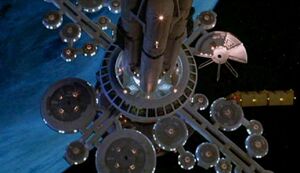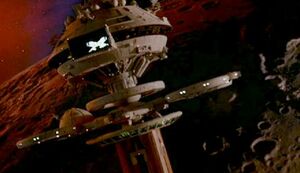Regula Class
More actions
The Regula-class space station is a small, ubiquitous Federation facility. They are modular platforms, configured for use in many roles ranging from orbital housing and office space for planetary facilities, to long-duration scientific missions in isolated areas, to control stations for defense grids. They are designed to be as simple and quick to build as possible. With a standard crew complement of 20, their systems are highly automated. The Regula design has been upscaled into the Vision and Anchorage-class stations that are also common within Federation space.
Mission Parameters
Regula-class stations are highly modular and easy to construct, so they can be assembled in a variety of configurations. While there is an endless degree of bespoke modules available, Starfleet currently operates four more or less standard configurations: orbital office complex, research facility, listening post, and tactical control station.
Orbital Office Complex

Regula-class orbital office complexes provide administrative facilities for small shipyards and planetary outposts. Their primary function is to coordinate the activities of other orbital assets, such as dry docks, communications satellites, and visiting starships. While they have a permanent crew of 20 that lives aboard, staff often commute from the surface of the world they orbit. They are suitable only for light-intensity operations, as they simply don't have the space or life support to handle hundreds of people aboard at a time. Orbital office complexes are very useful in orbit of planets where transporting to the surface is difficult, as they can provide a way station to welcome guests and arrange for shuttle travel planet-side. They are usually equipped with shields but not weapons. Gradually, stations of this type have been supplanted by Presidium-class stations, but this is only suitable in locations that really need these much larger stations.
Research Facility

Regula-class research stations are usually either specialized to study a single phenomenon or can handle two to three small, independent projects. Their small size is usually a feature, as it ensures that dangerous research can be conducted with minimal risk to sentient life. Individual modules can also be jettisoned in an emergency. They are usually equipped with shields, and outposts conducting sensitive research may also have weapons emplacements and/or defense satellites.
Listening Post
Located on the Federation's borders, Regula-class listening posts monitor incoming and outgoing traffic with long-range sensor pods. They also conduct deep space signals intelligence. Sometimes, these stations have subspace relay equipment as well. They report information back to the regional starbase, where it is then channeled to Starfleet Intelligence. These stations are not usually directly on the border, but they're always shielded in case something makes it passed the border outposts.
Tactical Control Station

While Regula-class stations are not effective combat platforms on their own, even when armed, many stations of this class coordinate defense grids. Often, they are the only crewed component of automated defense systems, providing a platform for critical decision-making that can't be handled by a computer. These stations sometimes support a pair of starfighters to perform security checks, as well. The modules on these stations are usually high-powered shield generators which ensure that the station can't easily be disabled.
Layout and Design
The main body of a Regula-class station is a roughly spheroid structure that contains the station's sole hanger (suitable for runabouts, shuttles, and other small vehicles), its primary living quarters, and command and control facilities. On the top of the station, there is a large antennae that maintains the station's connection with the subspace relay network. Under the main body, there is a largely-automated fusion reactor. Beneath that, there is a cross-shaped frame that allows for the installation of standard station modules, often office space and laboratories. The lowest habitable module is the station's small arboretum, which rings four large storage tanks for deuterium fuel, water, and other consumables. At the very end of the tanks is a navigational beacon that provides subspace and visual aid to starships operating nearby. In low gravity environments such as on moons or asteroids, the main body of the station can actually be installed directly onto a rocky body, with labs and other modules built into the ground beneath it.
Modules
The modules on Regula-class stations are usually one to three decks in height, though modules further from the center of the station can be taller. These round modules come in small, medium, and large diameters, with the small ones holding just one lab or a few offices and the larger ones capable of holding multiple facilities. They are interconnected to one another with passage-ways based on their function. Modules can either be transported by starship to the site or built directly on the station. Once a station has been built, it does not tend to remove existing modules, but sometimes expands as its mission shifts. A typical Regula-class station has four one-deck large modules in the positions closest to the center of the station. Bespoke modules are created for individual mission parameters, notably telescope and arboretum domes for some stations.
Docking Facilities
The hanger on Regula-class stations is suitable only for runabouts, shuttles, and other small vessels. It runs through the center of the station, with doors on either end, allowing access to both parking space and cargo facilities. While some of these facilities have been used as cargo receiving terminals, they are much too small for any serious commerce. Docking ports are found on some modules and at the ends of the module frames, for situations where starships must dock physically.
Defensive Capabilities
Even security-oriented versions of the Regula are typically unarmed, as their power generation capabilities simply can't support modern weapons very well. They do often have good shielding, though, in the hopes that they can wait out for assistance. On those stations where armaments are present, they are typically supplied from secondary power generators which must be installed as modules. They could also store two or three starfighters, but this would take up valuable pilot bunk space that could otherwise be used for scientists or mission specialists instead.
Station Life
Regula-class stations are small, cramped, and (often) isolated. As orbital platforms, this limitation does not impact the day-to-day lives of their crews very often, since they can just beam or shuttle down to the planet's surface. For far-off research posts, though, science teams must rely on their sense of curiosity and the (hopefully) collegial bonds they have with their teammates to make the most of their assignment. While the arboretum pod does provide greenery and a taste of M-class life, this can be a difficult post to thrive in for crew who prefer wide, open spaces.
These stations are often entirely civilian-run, but in that case all of the residents aboard are also part of the project being run there. They don't have civilians aboard running shops or restaurants, though scientists sometimes bring their families with them. Living quarters are equivalent to those aboard most Starfleet starships, so they're comfortable, but not as large as those found on actual starbases. Indeed, the life support systems could support a larger crew, but the decision was made to keep it limited in order to ensure that there was enough space every crew member. By the 25th century, most of these stations have been fitted with holosuites, which have dramatically reduced reports of boredom and fatigue amongst Regula crews.
Medical facilities are generally spartan, unless a station is being used as an orbital hospital. Often, there's not even a full-time medical officer aboard, and these stations rely on Long-Term Medical Holograms for routine care and visiting starships for more advanced procedures. Starfleet does, however, mandate that a counselor be assigned to stations where crew are expected to be deployed for more than a year at a time, or that a starship make routine visits to provide that service.
History
The first Regula-class station was built in orbit of Regula II in the Mutara System in the 2270s, though other units were already being built around the Federation as well. This facility was intended as a modern, modular station that could do most any mission type without needing all of the infrastructure of a K-class station. These stations have been in continual production since their introduction, even as other station types become available, because of their ease of construction and upgrade. Dubbed an instant success, the Regula-class station later gave rise to a successor to the Watchtower, the scaled up Anchorage, as well as the mid-sized Vision. At the beginning of the 25th century, the Regula can be found throughout Federation space and continues to be an important part of many different Starfleet and Federation missions.
Regula-class Stations In-Play
- Regula-class stations are the smallest playable station type in Bravo Fleet. With a crew of just 20 (or fewer, if you want), they're meant to be cramped and isolated. This has a lot of opportunities for storytelling and really delving into the motivations and growth of a core group of characters.
- These stations are everywhere, both on the frontier and in the background in core systems. They're a good setting for an NPC base, particularly where one needs to investigate something gone horribly awry without needing to explain why a larger station would have such a fate befall it.
- Though small, these stations are versatile. Modules mean they can do a lot of different things. The four types provided above are just examples. Maybe you want an orbital ER, the upper end of an orbital elevator, or some sort of deep space vault. There are tons of possibilities.
Regula-class Stations of the Fourth Fleet
- Base Rho-7, on the coreward border of the Federation.

